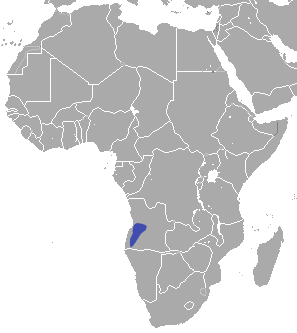
Heliotropium is a genus of flowering plants in the heliotrope family, Heliotropiaceae. There are around 325 species in this almost cosmopolitan genus, which are commonly known as heliotropes. They are highly toxic to dogs and cats.

The black myotis is a vesper bat species from South and Central America.

The tree martin is a member of the swallow family of passerine birds. It breeds in Australia, mostly south of latitude 20°S and on Timor island. It is migratory, wintering through most of Australia, New Guinea, Indonesia east of the Wallace Line and the Solomon Islands. It is a vagrant to New Zealand, where it has bred, and New Caledonia. This species is frequently placed in the genus Hirundo as Hirundo nigricans.

The blackish white-toothed shrew is a species of mammal in the family Soricidae. It is endemic to Angola.

Heliotropium arboreum is a species of flowering plant in the borage family, Boraginaceae. It is native to tropical Asia including southern China, Madagascar, northern Australia, and most of the atolls and high islands of Micronesia and Polynesia. Common names include velvetleaf soldierbush, tree heliotrope, veloutier, and octopus bush. It is a shrub or small tree typical of littoral zones reaching a height of 3.6 m (12 ft), with a spread of about 5 m (16 ft).
Heliotropium aff. wagneri is an undescribed plant in the family Boraginaceae. It resembles Heliotropium wagneri, but differs in fruits breaking up into four nutlets and flowers that are always yellow, never white.
Heliotropium anderssonii is a species of plant in the family Boraginaceae. It is endemic to Ecuador.
Heliotropium argenteum is a species of plant in the family Boraginaceae. It is endemic to Ecuador. Its natural habitat is subtropical or tropical dry shrubland. It is threatened by habitat loss.
Heliotropium balfourii is a species of plant in the family Boraginaceae. It is endemic to Yemen. Its natural habitats are subtropical or tropical dry forests and subtropical or tropical dry shrubland.
Heliotropium dentatum is a species of plant in the family Boraginaceae. It is endemic to Yemen. Its natural habitats are subtropical or tropical dry forests and subtropical or tropical dry shrubland.
Heliotropium derafontense is a species of plant in the family Boraginaceae. It is endemic to Yemen.
Heliotropium kuriense is a species of plant in the family Boraginaceae. It is endemic to Yemen. Its natural habitat is subtropical or tropical dry shrubland.
Heliotropium paulayanum is a species of plant in the family Boraginaceae. It is endemic to Yemen. Its natural habitat is subtropical or tropical dry shrubland.
Heliotropium riebeckii is a species of plant in the family Boraginaceae. It is endemic to Yemen. Its natural habitats are subtropical or tropical dry shrubland and subtropical or tropical wet lowland grassland.
Heliotropium shoabense is a species of plant in the family Boraginaceae. It is endemic to Yemen.
Heliotropium socotranum is a species of plant in the family Boraginaceae. It is endemic to the island of Socotra. Its natural habitats are subtropical or tropical dry forests and subtropical or tropical dry shrubland.
Heliotropium wagneri is a species of plant in the family Boraginaceae. It is endemic to Yemen. Its natural habitats are subtropical or tropical dry shrubland and subtropical or tropical dry lowland grassland.
H. nigricans may refer to:

Schoenus nigricans is a species of sedge known by the common names black bog-rush and black sedge. It is native to Eurasia, parts of Africa, Australia, and southern North America, including Mexico and the southernmost United States. It grows in many types of wetlands and other moist and alkaline habitat, including marshes, springs, seeps, peat bogs, heath, and alkali flats. This perennial plant grows in low, tight clumps 20 to 70 centimeters tall, with threadlike leaves bearing wide, dark brown ligules. The inflorescence is a small, flattened cluster of dark spikelets. The fruit is an achene coated in a hard, white shell.






